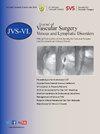Longitudinal impact of Intersocietal Accreditation Commission vein treatment center accreditation on practice patterns, safety metrics, and patient outcomes
IF 2.8
2区 医学
Q2 PERIPHERAL VASCULAR DISEASE
Journal of vascular surgery. Venous and lymphatic disorders
Pub Date : 2025-09-15
DOI:10.1016/j.jvsv.2025.102315
引用次数: 0
Abstract
Objective
With health care rapidly expanding and patient accessibility needs increasing, there has been an influx of providers often lacking formal training in venous disease management. The aim of this study was to determine if centers that participate in an accreditation program exhibit increased quality, safety outcomes, and overall practice standards.
Methods
Of 325 accredited vein centers, 287 underwent reaccreditation within 3 years. Fifty-nine of them were compliant with Intersocietal Accreditation Commission (IAC) standards at the time of initial accreditation. Fifty-nine IAC-accredited centers participated in the American Vein and Lymphatic Society Pro Vein registry and had patient-level data. Sixteen were initially compliant with IAC standards (group 1; 4977 patients) and 43 had deficiencies (group 2; 11,179 patients). A stratified before-and-after design was used to analyze center-level and patient-level data (demographics, body mass index, and disease severity scores [Clinical-Etiological-Anatomical-Pathophysiological and revised Venous Clinical Severity Score (VCSS)]. Primary outcomes included compliance with IAC standards, treatment results (eg, VCSS changes, complications, endothermal heat-induced thrombosis >2), and interventional practice patterns, such as intervention rate and Utilization Index.
Results
Of the 287 IAC-accredited vein centers who pursued reaccreditation, 59 were compliant initially and at reaccreditation. The remaining centers (n = 229) had multiple deficiencies, with safety issues persisting in some centers at reaccreditation. Before accreditation, group 2 centers treated younger, lower body mass index patients with less severe disease, and group 1 centers saw more advanced cases. Over time, group 2 centers began treating more severe cases. Group 1 had higher intervention rates and lower use indices before accreditation. Post-treatment complication and endothermal heat-induced thrombosis rates were low and similar across both groups. Group 1 showed a greater VCSS score change after treatment, partly owing to higher baseline scores. Over time, group 2 showed a decrease in Utilization Index, without a post-treatment decrease in the revised VCSS change aligning with group 1, indicating improved practice patterns after accreditation.
Conclusions
IAC accreditation plays a meaningful role in standardizing and improving the quality of outpatient venous care. It promotes safer procedural environments, encourages more selective use of interventions, and is associated with improved clinical outcomes—particularly among initially noncompliant centers. These findings support the expansion of accreditation programs and underscore their importance in maintaining high standards of care in an increasingly heterogeneous field.
IAC静脉治疗中心认证对实践模式、安全指标和患者预后的纵向影响。
目的:随着医疗保健的迅速扩大和患者的可及性需求的增加,有大量的提供者往往缺乏正规的静脉疾病管理培训。本研究的目的是确定参与认证计划的中心是否表现出更高的质量、安全结果和整体实践标准。方法:325个经认证的静脉中心中,287个在3年内进行了重新认证。其中59个在初步认可时符合国际咨询委员会的标准。59家IAC认可的中心参与了AVLS Pro静脉登记,并获得了患者水平的数据。16例最初符合IAC标准(第1组,4977例),43例存在缺陷(第2组,11179例)。采用分层前后设计分析中心水平和患者水平的数据(人口统计学、BMI、疾病严重程度评分(CEAP和rVCSS))。主要结局包括是否符合IAC标准、治疗结果(如VCSS改变、并发症、EHIT >2)和干预实践模式(如干预率和利用指数)。结果:在287家iac认可的静脉中心中,有59家在最初和重新认证时都是合规的。其余229家中心存在多重缺陷,一些中心在重新认证时仍存在安全问题。在获得认证之前,第二组中心治疗的是较年轻、bmi较低且病情较轻的患者,而第一组中心治疗的是更多晚期病例。随着时间的推移,第二组中心开始治疗更严重的病例。1组干预率较高,认可前利用指标较低。两组治疗后并发症和EHIT发生率均较低且相似。第1组治疗后VCSS评分变化较大,部分原因是基线评分较高。随着时间的推移,第2组的利用率指数下降,治疗后rVCSS变化没有下降,与第1组一致,表明认证后的实践模式有所改善。结论:IAC认证对规范和提高门诊静脉护理质量具有重要意义。它促进了更安全的程序环境,鼓励更有选择性地使用干预措施,并与改善的临床结果有关,特别是在最初不合规的中心。这些发现支持了认证项目的扩展,并强调了它们在日益多样化的领域中保持高标准护理的重要性。
本文章由计算机程序翻译,如有差异,请以英文原文为准。
求助全文
约1分钟内获得全文
求助全文
来源期刊

Journal of vascular surgery. Venous and lymphatic disorders
SURGERYPERIPHERAL VASCULAR DISEASE&n-PERIPHERAL VASCULAR DISEASE
CiteScore
6.30
自引率
18.80%
发文量
328
审稿时长
71 days
期刊介绍:
Journal of Vascular Surgery: Venous and Lymphatic Disorders is one of a series of specialist journals launched by the Journal of Vascular Surgery. It aims to be the premier international Journal of medical, endovascular and surgical management of venous and lymphatic disorders. It publishes high quality clinical, research, case reports, techniques, and practice manuscripts related to all aspects of venous and lymphatic disorders, including malformations and wound care, with an emphasis on the practicing clinician. The journal seeks to provide novel and timely information to vascular surgeons, interventionalists, phlebologists, wound care specialists, and allied health professionals who treat patients presenting with vascular and lymphatic disorders. As the official publication of The Society for Vascular Surgery and the American Venous Forum, the Journal will publish, after peer review, selected papers presented at the annual meeting of these organizations and affiliated vascular societies, as well as original articles from members and non-members.
 求助内容:
求助内容: 应助结果提醒方式:
应助结果提醒方式:


